Brangus cattle are a domestic breed mainly used for meat production. They are also hybrids created through a crossbreeding process.
The name “Brangus” reflects this, with “Bra” coming from the modern Brahman stock and “ngus” from the American Angus breed.
This breed originated in the United States during the early 20th century.
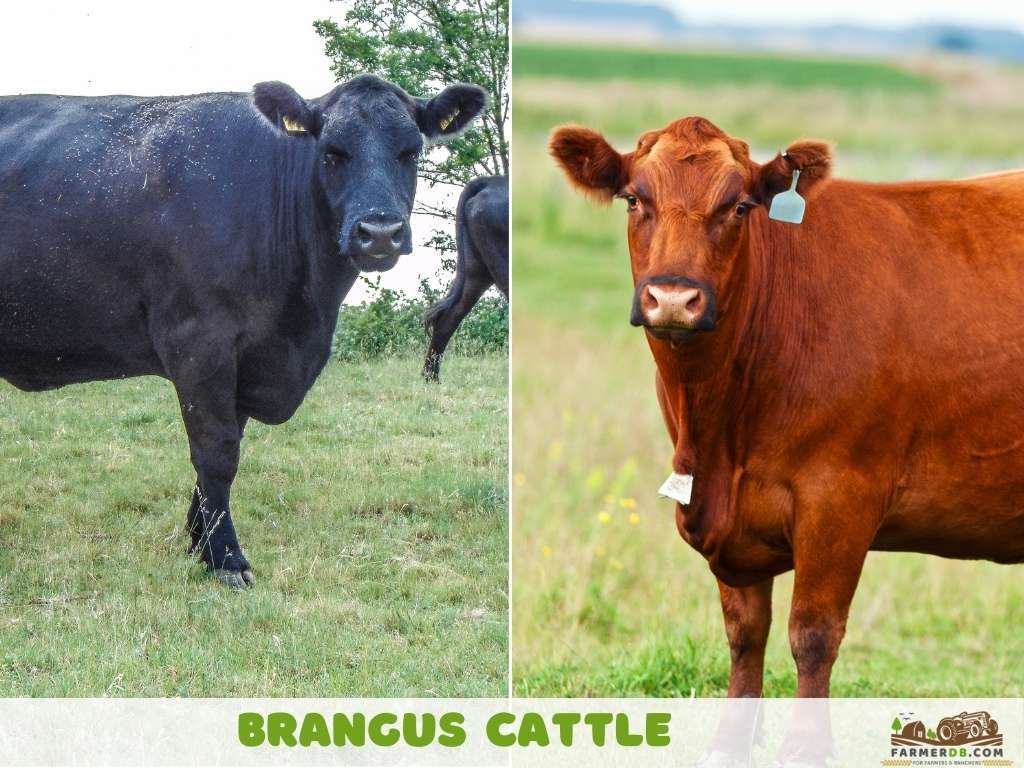
It was developed to combine Brahman cattle’s heat tolerance and disease resistance with the high-quality beef production and adaptability of Angus cattle.
The genetics of Brangus cattle are stabilized at 3/8 Brahman and 5/8 Angus.
This balance makes them strong and efficient meat producers in various climates.
The breed is present in multiple countries, with significant populations in Brazil, Mexico, and South Africa.
Contents
Variations of Brangus Cattle
There are a few types of this cattle breed that have been developed to suit different needs and environments.
The key differences between the variations are coat color, adaptability to different climates, and genetics.
Black Angus
This is the standard and most widely recognized type of Brangus, with a solid black coat.
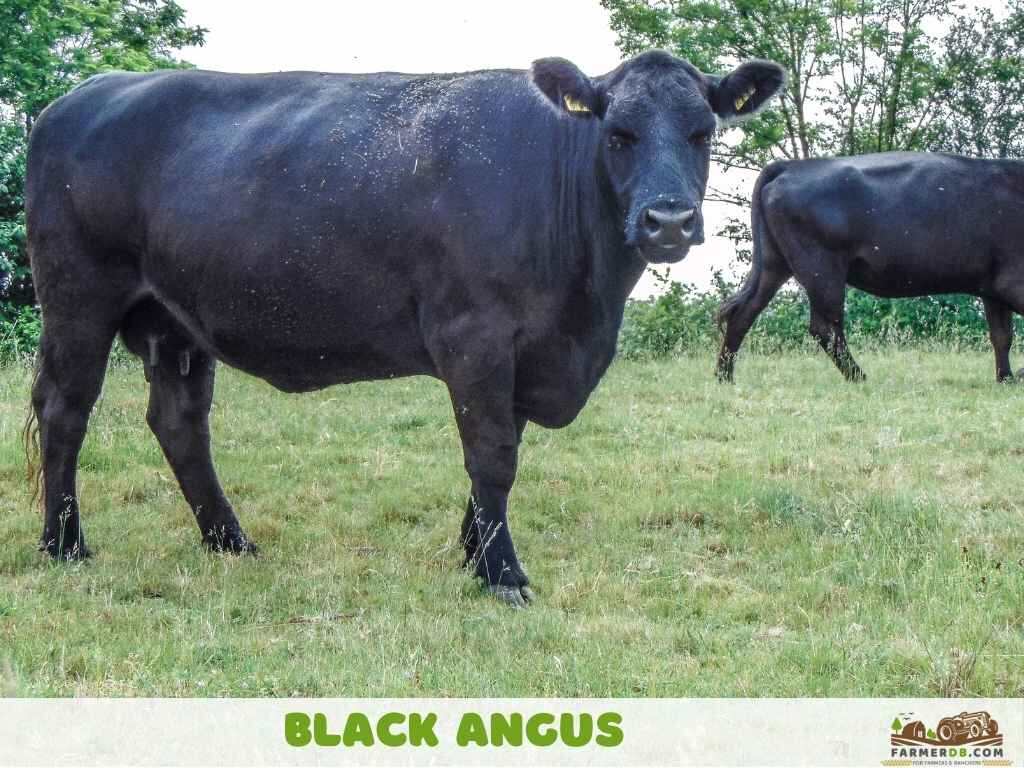
It was designed to combine the traits of heat tolerance, disease resistance, and high-quality beef production.
Red Angus
This variation has a solid red coat instead of black.
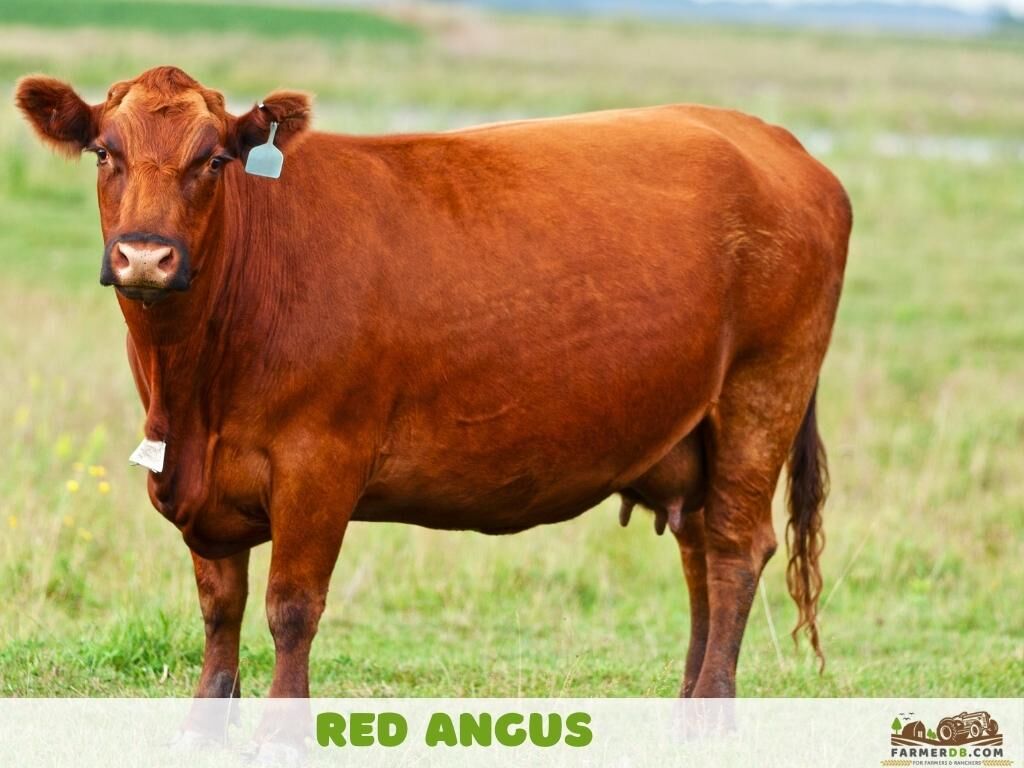
It was developed by selecting for red coloration to better suit hot climates, as red-coated cattle are thought to tolerate heat even better than black-coated ones.
UltraBlack and UltraRed Brangus
These are newer variations created by introducing more Angus genetics into the Brangus breed.
UltraBlack has a predominantly black coat, while UltraRed has a red coat. They are designed to improve certain production traits, such as beef quality.
| Type | Coat Color | Genetics | Purpose |
|---|---|---|---|
| Black Brangus | Solid black | 3/8 Brahman and 5/8 Angus | Performs well in hot climates but is versatile enough for various regions. |
| Red Brangus | Solid red | Similar to Black Brangus (3/8 Brahman and 5/8 Angus), but with a red coat gene. | Popular in very warm or tropical climates. |
| UltraBlack and UltraRed Brangus | UltraBlack: Solid black UltraRed: Solid red |
These have a higher percentage of Angus genetics (closer to pure Angus) while still retaining Brahman traits for heat tolerance and adaptability. | Slightly less adapted to extreme heat compared to traditional Brangus but excellent for improving beef quality in temperate or warm regions. |
Characteristics
As a crossbreed, this cattle has developed a unique combination of traits by blending the best qualities of its Brahman and Angus ancestors.
Color
- Black Brangus: The coat is uniformly solid black.
- Red Brangus: The coat is entirely solid red.
- UltraBlack Brangus: The coat is solid black.
- UltraRed Brangus: The coat is solid red.
These cattle are known for their solid coat color, whether black or red, without any white spotting or markings. Cattle with white spotting are not recognized by breed associations as true Brangus, as solid coloring is a defining characteristic of the breed standard.
Head, Eyes, Face
The head reflects masculinity or femininity depending on the animal’s sex.
It is broad with a straight profile and a slightly rounded forehead.
The muzzle is wide and full, with large nostrils, while the eyes are gentle, well-spaced, and expressive. The dark pigmentation around the eyes helps protect against the sun, making this breed particularly suited for hot climates.
Horns
They are naturally polled.
This trait comes from the Angus side of their genetics and is a desirable feature for ease of handling and reducing the risk of injury among animals.
Neck
The neck is clean and well-defined, smoothly connecting to the shoulder, with loose folds of skin underneath.
The presence of skin folds is essential, as it is regarded as a standard of excellence for this breed.
Shoulders
The shoulders are smooth and well-covered over the blades, with a broad top, while the heart girth is deep and wide.
Body
The body is strong and muscular, with a broad, level back that is smoothly covered. The ribs are wide and well-rounded, blending seamlessly with the back and rump.
Hooks, Rump, Thighs, and Legs
Hooks, rump, and thighs are all wide, flat, and evenly fleshed. The legs are straight, of medium length, and evenly positioned.
Coat
The coat is short, smooth, and straight, creating a sleek appearance.
Udder and Teats
The udder is well-formed, symmetrical, and proportionate to the body size. The teats are of moderate size, evenly spaced, and well-placed, making them suitable for nursing calves.
Testicles
The testicles are well-developed, of equal size, and hang in a symmetrical, firm scrotum.
Size
These cattle are classified as a medium-to-large breed.
Mature bulls typically stand around 50–58 inches (127–147 cm) at the shoulder, while mature cows are slightly smaller, averaging 48–54 inches (122–137 cm).
They also can have a body length ranging from 70–80 inches (178–203 cm), depending on sex and individual genetics.
Keep in mind that these measurements are approximate and can vary based on factors such as genetics, diet, and overall management practices.
Lifespan
These cattle have a lifespan of approximately 12-15 years.
Their lifespan can vary as it is closely connected to genetics, health care, and diet.
For example, those actively involved in breeding have a lower average lifespan of around 12 years, while those provided with good care and management can live beyond 15 years.
Under proper care and management, some cows can stay productive well into their late teens, especially in breeding programs. Bulls, however, typically have shorter productive lifespans, usually retiring from breeding at around 8 years of age.
Growth Rate
How fast do they grow?
These cattle have a moderate to fast growth rate.
They have a strong average daily gain (ADG) ranging from 2.5 to 3.5 lbs per day (1.1 to 1.6 kg/day), placing them very close to the growth rate of Charolais cattle, though not surpassing it.
Weight
Their weight ranges from 1,100 to 2,200 lbs (499 to 998 kg).
Bulls typically weigh 1,800 to 2,200 lbs (816 to 998 kg) at 2 to 3 years of age, while cows mature slightly earlier, reaching a weight of 1,100 to 1,500 lbs (499 to 680 kg).
Calves are usually weaned at about 7–8 months old and typically weigh between 500–600 lbs (227–272 kg) at that time.
By 12 months, Brangus cattle generally reach a weight of 850–1,100 lbs (386–499 kg), depending on their sex and how well they are fed and cared for.
Slaughtered Time
You can prepare these cattle for slaughter between the ages of 18 to 24 months. At this time, cattle of this breed typically have a live weight of around 1,200–1,500 lbs (544–680 kg).
There are farmers who choose to slaughter them earlier, at 12 to 16 months, as they approach 1,000–1,200 lbs (454–544 kg). The exact timing of slaughter depends on your goals and the type of meat you wish to produce.
Temperament and Behaviour
They are easy to handle because of their calm and gentle temperament.
They are also very friendly and do not scare easily, which makes them simple to manage. This calm behavior is helpful, as it stops them from overreacting and causing problems for their caregiver. They deal with stress and new situations better than some other breeds, making them easier to move or handle in different environments.
They enjoy being social and prefer living in herds but are also happy to be around other animals. With proper care and training, they are comfortable with humans and other farm animals, which makes them good for mixed farming.
These animals are curious and may come closer to humans or objects to investigate. They are not known to try to escape, as long as the fencing is strong and secure. Their relaxed nature usually stops them from panicking or running away.
They also love to graze and spend much of their time eating grass and other plants, which is a big part of their daily life.
Meat
Brangus cattle are well-known for producing high-quality beef with excellent marbling and minimal excess fat.
Their meat features a rich, deep red color, often associated with premium beef. This color, combined with the fine marbling of fat within the muscle, enhances its juiciness and flavor.
The beef from Brangus cattle is also highly tender. Tenderness was scientifically measured using the Warner-Bratzler Shear Force (WBSF) test(see refs.). On average, Brangus beef recorded a WBSF value of 5.10 kg (11.2 lbs), which falls within the range for tender beef.
Brangus beef is particularly appealing to health-conscious consumers due to its lean nature. Despite having less external fat, the meat retains its flavor and high quality.
Raising
Feeding
These cattle have a good feed conversion ratio.
You can provide your cattle with a forage-based diet as their primary feed source, consisting of grass during warm seasons and hay or silage during dry or colder seasons when grass availability is lower.
For pasture grass, you can plant Bermuda, ryegrass, or Bahia, while alfalfa, timothy, or clover are excellent substitutes for hay.
Breeding Cattle: Maintain a forage-based diet supplemented with minerals and occasional protein during low-pasture conditions.
Optionally, you can supplement their feed with grains such as corn, barley, or oats, as well as protein supplements like soybean meal or commercial cattle cubes. These supplements are particularly beneficial for promoting weight gain, especially for finishing cattle.
Finishing Cattle: For beef production, you can introduce a grain-based diet in the final 90–120 days to enhance marbling and tenderness.
Fresh, clean water must always be available to ensure their hydration and health.
A mineral block or a loose mineral mix (containing salt, calcium, phosphorus, and trace minerals) should be provided at all times to meet their nutritional needs.
Environment
Brangus cattle are highly adaptable and can grow in a variety of environments, but they are best suited for areas with ample access to pasture for grazing
Climate
| Variation | Climate |
|---|---|
| Black Brangus | Warm and temperate regions |
| Red Brangus | Hot and humid areas |
| UltraBlack Brangus | Temperate climates |
| UltraRed Brangus | Hot and arid environments |
Black Brangus are well-suited for areas with hot summers and moderate winters. Their Brahman genetics help them tolerate heat and provide resistance to diseases. Regions like the Southern United States, South America, and parts of Australia are ideal for them.
Red Brangus do well in hot and humid climates. Their red coat reflects sunlight better than black-coated cattle, making them more comfortable in extreme heat. They are a good fit for tropical and subtropical areas, such as Central and South America, parts of Africa, and hotter regions in Australia and the U.S..
UltraBlack Brangus are better suited to temperate climates. With a higher percentage of Angus genetics, they may not handle extreme heat as well as traditional Brangus but still retain some heat tolerance.
UltraRed Brangus performs well in hot and dry regions, similar to Red Brangus. Their red coat protects them from heat stress, and they adapt well to arid and less fertile environments. These traits make them ideal for semi-arid areas in regions like Australia, Africa, and the American Southwest.
Shelter
Like most cattle breeds, these also benefit from having a shelter.
While they are well-adapted to hot climates, they need access to shade. It does not have to be a complex or elaborate shelter. Trees or a simple structure are enough to protect from prolonged sun exposure, wind, or heavy rain.
During calving, cows should also have access to a secure and dry shelter to protect their newborns.
How many cattle per acre?
You can raise 1 cow per 3 to 4 acres in areas with high-quality pasture and sufficient rainfall.
For moderate pasture quality and moderate rainfall, you will need 4 to 5 acres per cow. On low-quality pasture, the requirement increases to 5 to 11 acres per cow.
The amount of land needed also depends on how much you supplement their feed. If a higher percentage of their daily diet comes from supplemental feed, you may require less land overall.
Breeding
Breeding this type of cattle is more complex than breeding other breeds. It requires careful planning to ensure the cattle possess the correct traits for certification.
One way to breed them is to start by buying a cow or several cows. Next, you can get semen from farms or trusted breeding organizations that specialize in Brangus genetics.
With artificial insemination (AI), you can add the desired traits to your herd. This method lets you choose top-quality genetics from tested bulls without needing to keep a bull on your farm.
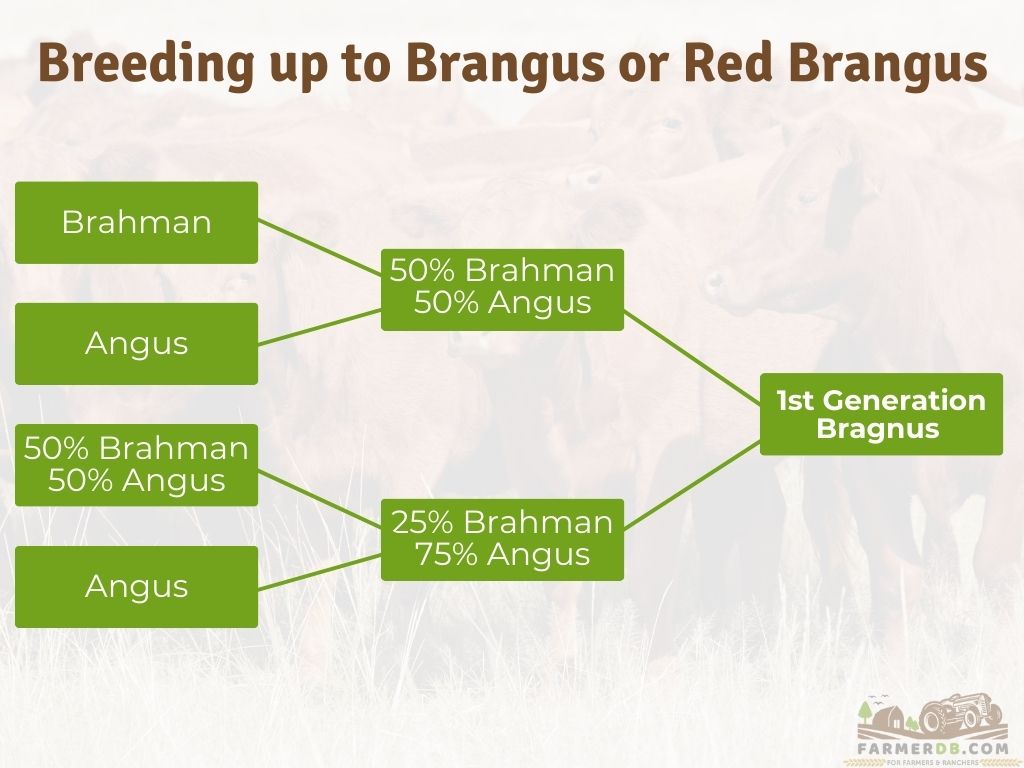
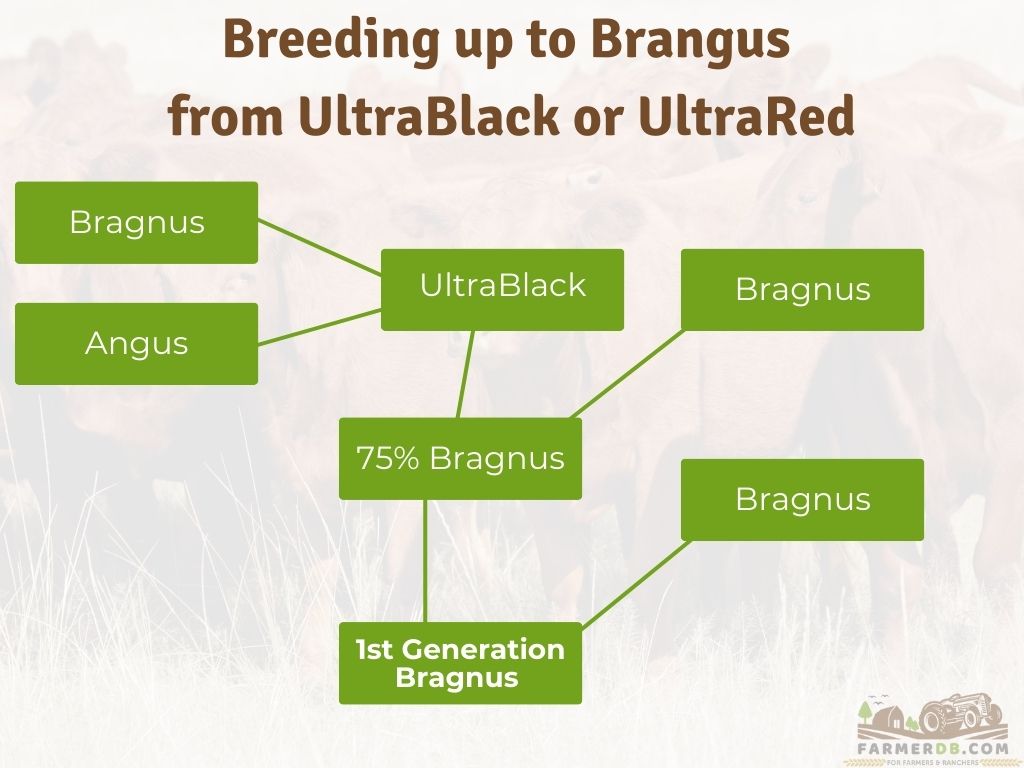
However, if you already have a Brangus bull and cow, breeding them is simpler since both animals already possess the desired 5/8 Angus and 3/8 Brahman genetics.
Over time, you can either continue breeding within your herd or introduce new Brangus genetics by purchasing additional bulls or cows. This helps maintain genetic diversity and prevents issues related to inbreeding.
Cows can be bred starting at around 18 months of age and continue calving until they are about 10–11 years old, depending on their health and care. On average, a cow can have 8–9 or more calves in her lifetime.
Brangus bulls are known for having a higher libido than other cattle breeds, which makes them efficient breeders.
These cattle can be bred naturally by introducing the bull to the cow during her heat. Female cattle (cows) come into heat every 18–21 days. After breeding, it is recommended to check for pregnancy about 30–45 days later.
The gestation period lasts approximately 9 months (280–290 days). Brangus cows are known for their ability to give birth easily, with minimal assistance needed.
These cattle are considered maternal, known for their excellent mothering abilities.
Did you know: Bulls play a significant role in crossbreeding programs. They are often used in these programs to enhance specific traits in other cattle breeds due to their unique genetic composition.
Health Issues
In general, they are hardy and resilient, but they can still experience common cattle health issues, such as hoof problems or bloat.
Regarding diseases specific to their breed, they may be prone to certain genetic conditions, such as:
- Curly calf syndrome(see refs.): lethal condition causing stillborn calves with twisted spines and limb deformities.
- Fawn calf syndrome(see refs.): mutation causing reduced limb mobility in Angus-influenced cattle.
- Water head syndrome(see refs.): mutation causing calves to be born dead with an enlarged skull and little brain tissue.
- Mule foot(see refs.): mutation causing fused hooves.
Why should you raise it
This cattle breed is a great choice for homesteaders, small farmers, and even commercial farming.
For homesteaders and small farmers, it is ideal because it requires little maintenance and has a calm and gentle nature, making it enjoyable to work with and reducing the risk of accidents.
Not to mention, if you live in hot, humid, or arid climates, these cattle are a reliable choice.
Its good feed conversion rate is budget-friendly, and its hardiness means it rarely needs veterinary attention. However, one potential drawback for some is the breeding process. Artificial insemination is often used with this breed, which can feel more complicated or less natural than traditional mating.
Another consideration is the higher price of this breed compared to others that may offer a similar amount of meat and quality for a lower cost.
The price for a bull typically ranges from $2,500 to $6,000. In some cases, they have even been sold for as much as $10,000.
A&D
Advantages
- Heat tolerance due to Brahman genetics.
- Disease resistance, especially in tropical climates.
- High-quality beef with excellent marbling.
- Easy calving and strong maternal instincts.
- Adaptability to diverse environments.
- Efficient grazing and forage conversion.
- High fertility rates.
- Great mothering skills, ensuring healthy and strong calves.
- Easy to care for, even in low-maintenance systems.
Disadvantages
- Requires adequate pasture and nutrition for optimal performance.
- May not thrive in extreme cold climates.
- Genetic conditions require monitoring.
- Initial breeding setup can be more complex compared to other breeds.
- Higher management needs for large-scale operations.


